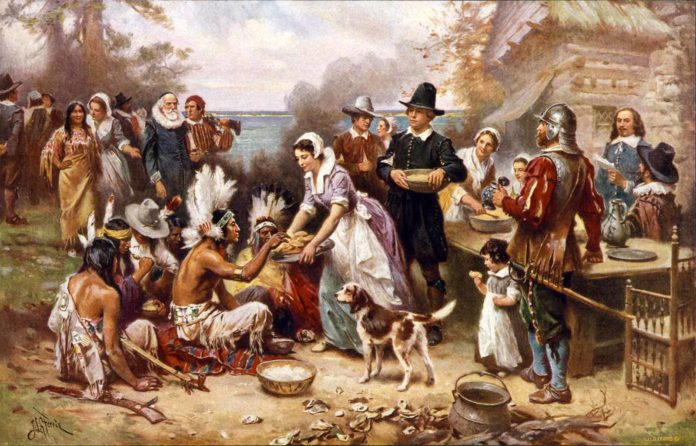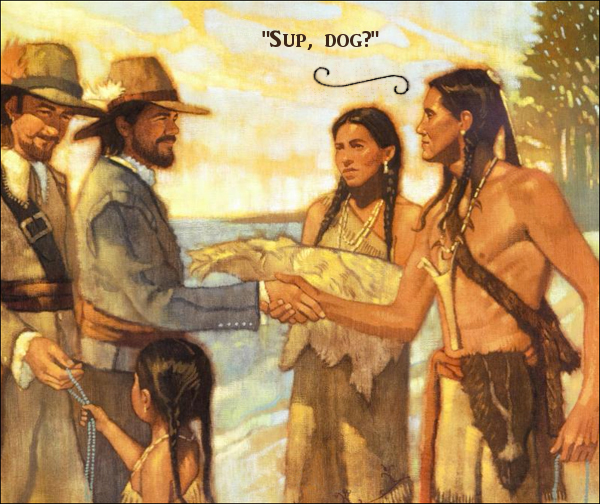
Voice inserts: [responsivevoice voice=”UK English Female” buttontext=”Play”]
Most Americans know the basic Thanksgiving story: English Pilgrims who sought religious freedom landed in Plymouth, Massachusetts and were greeted by Squanto, who in turn taught them to plant corn. The actual story, according to historian Charles Mann, author of 1491: New Revelations of the Americas Before Columbus, is a bit more complicated.
First, here’s the History Channel’s detailed version of events:
The true story behind Squanto, who was also known as Tisquantum, isn’t quite as pleasant as the mainstream story would suggest. According to Paula Peters, member of the Mashpee Wampanoag tribe:
“This is not revisionist history, this is history that’s just been overlooked because people have become very, very comfortable with the story of happy Pilgrims and friendly Indians. They’re very content with that—even to the point where no one really questioned how is it that Squanto knew how to speak perfect English when they came.”
Apparently, Squanto had been kidnapped by an Englishman named Thomas Hunt, six years before the Pilgrims arrived. He was then taken to Spain, where Hunt tried to sell him; however, this action was met with disapproval, and with the help of Catholic friars, Squanto escaped, made his way to England, and eventually back to Massachusetts.
While Squanto was away, an epidemic—believed to be hepatitis—hit New England, wiping out large populations. When Squanto returned home, he found he was the only survivor left in his village (Patuxet).
“Into this bumbled the Pilgrims,” Mann said. “They had shown up in New England a few weeks before winter… Up until the Pilgrims, the pattern had been pretty clear. Europeans would show up, and Indians would be interested in their trade goods, but they were really uninterested in letting [Europeans] permanently occupy land.”
Armed Natives would often, at this time, force Europeans to leave if they attempted to stay too long; however, after the hepatitis epidemic, the Natives were unable to stop them from settling in the area. Squanto wasn’t trusted by the local tribes, and was actually held in a sort of “house arrest” until the Pilgrims arrived and started starving to death everywhere. The Wampanoag chief who was holding Squanto, known as Massasoit, thought of an idea.
With the Wampanoag population nearly decimated by disease, he decided to team up with the Englishmen, thereby controlling the trade out of England. Squanto was brought along to translate, but was soon caught trying to pit the Pilgrims against the Wampanoag Chief.
According the Mann, Massasoit “is just pissed off and demands the Pilgrims hand him over because he’s gonna execute him.” They don’t. Instead, Squanto stays with the colony and helps them prepare for winter.
By the next fall, the Pilgrims were secure enough to take care of themselves, and held a “feast of thanksgiving.” Massasoit showed up with around ninety men, all of which were armed, and the Pilgrim militia responded by marching around and firing their guns in the air. Both sides eventually came to a truce of sorts, sat down, ate a lot of food together, and bitched about it the whole time.
In a statement from Paula Peters:
“While it was by far not the first occasion of human trafficking conducted by European explorers to the new world, the capture of Squanto and his fellow tribesmen would forever alter the course of history for people on two continents.”
Mann adds, “We learn about Columbus landing in 1492 and it’s as if nothing happened for over 100 years until the Pilgrims landed. But the Tisquantum story gives you this tiny peek into that all the people involved had been interacting for more than a century.”
Now you’ve all got an interesting story for next year’s Thanksgiving. Cheers.
[/responsivevoice]
This Article (Now That Thanksgiving Is Over, What Did We Just Celebrate?) is a free and open source. You have permission to republish this article under a Creative Commons license with attribution to the author and AnonHQ.com.





